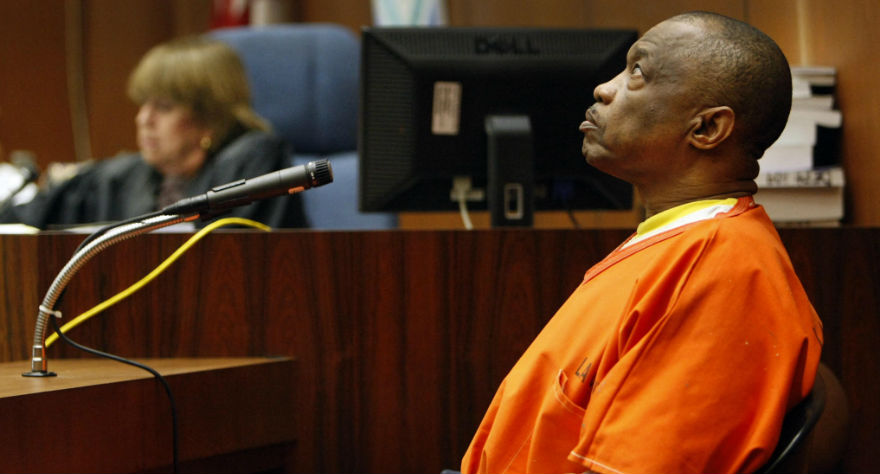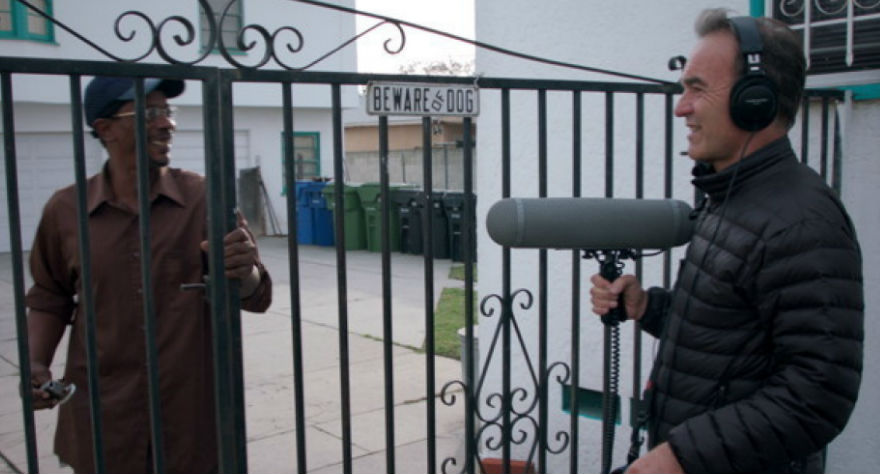Nick Broomfield on ‘Tales of the Grim Sleeper’ and Apartheid in LA

Nick Broomfield (Sarah Palin: You Betcha!, Biggie and Tupac) is a filmmaker with a purpose. His on-the-move, cut-to-the-core style of documentary filmmaking is on display more than ever in his latest project, Tales of the Grim Sleeper, a murder mystery that blooms into a stirring profile of a community forgotten and forsaken by the outside world.
The film pivots on Broomfield’s investigation of a serial killer named Lonnie Franklin, who was arrested in 2010 after going on a 25 year killing spree in which he allegedly abused and murdered over 100 women in South Central Los Angeles. Enlisting the help of a crafty, charismatic ally named Pam and the Black Coalition Fighting Back Serial Murder, Broomfield set out to find surviving victims of the Grim Sleeper in the impoverished community in order to crack open the long-stagnant case.
The question at the center of Grim Sleeper isn’t so much about Franklin himself as it is the troubling state of law enforcement in South Central. Why did it take so long to catch Franklin, who may be the most prolific serial killer in history? Society has turned a blind eye to communities like South Central, and Broomfield’s film exposes the dire consequences of such negligence, which he rightly equates to apartheid.
I had a chance to speak with Broomfield about the film, which is airing now on HBO.

The Q&As for this movie must be intense.
I think people are shocked that the people in South Central are so wonderful. Also, there’s complete amazement that these murders could have gone on for so many years and police didn’t do anything about it. They’re shocked that this kind of racism and, in a way, an apartheid system, is in existence. There’s so little communication between the wealthy areas in most American cities, like LA. People in Santa Monica or Beverly Hills would never ever go into South Central, and people from South Central would rarely go into the wealthier parts of the city. Because of that, communication has really broken down. One group of people live in absolute poverty, and if there’s a murder, no one does anything about it.
I couldn’t believe that people didn’t put together that there was a serial killer running around for years and years.
It’s not reported in the newspapers. Over 250 women disappeared, but none of it was reported. People just didn’t know, and the police didn’t admit there was a serial killer on the loose for twenty years or so. When I asked [an officer] about that, he said they didn’t want to tip the serial killer off by saying that they knew. It was such rubbish, kind of laughable. In the meantime, the community didn’t know there was a killer on the loose, so they didn’t have plans to patrol the streets or prepare themselves. The police weren’t functioning properly.
When I met with Christopher Franklin, the son of the so-called Grim Sleeper, he said the amazing thing was that his father had so many fans in law enforcement, which I thought was astonishing. He said sheriffs would run up to him and shake his hand. “You’re the son of the Grim Sleeper!” They thought he was so cool because he was clearing the streets of prostitutes and drug addicts, saving their time.
For a lot of people in this country, the crack epidemic is a thing of the past. It was an ’80s thing or a ’90s thing. But in this community, it’s very much still alive.
There has never been any real systematic attempt to deal with the crack epidemic in South Central. A lot of people who are addicted to crack are deliberately excluded from the programs that can get them off addiction. You’ve got this catch-22 where the people who have the biggest problems–they’re addicted, have a felony conviction for possession–are the ones who can’t actually get over their addiction. What is required is a systematic approach to that whole community to get rid of the epidemic.
When I finished the film, the thing that immediately jumped out at me was that the title had transformed. At first, I thought the operative words were Grim Sleeper, but in fact, your focus in the movie is actually the Tales rather than the man himself.
As soon as I thought of Tales, I knew that was it. It’s a wider story than a literal whodunnit about the Grim Sleeper. It’s not, “Did he do it?” It’s, “How is this possible at all that it went on for 25 year period?”
Your approach to filmmaking is an adaptive one. You go into projects without a real agenda. But like you say in the movie, you were a couple of English white guys strolling into South Central. What was your “in?”
I spent a long time interviewing different people who might do just that for us. That’s the single most difficult thing when you start. I think there had been a lot of crews going in there in the past, news crews who had gone in and upset people in the neighborhood. We managed to find a well-known comedian called Tiffany Haddish, who’s on the Kevin Hart show. She’s wonderful. She’d grown up on the street next to Lonnie Franklin. She was the one who took us into the community, where she’s very respected. When they started calling me “peckerwood” and stuff, she’d [give them grief], and they all fell in love with her. She was the ideal person to go in with. She was supposed to be working on the film more, but she was too busy with auditions and things. We met Pam very early on, and she became our guardian angel.
She was your key to the city.
Key to the city! The awful thing is, Pam is looking for a job now even though she’s so bright and gifted and dependable. It’s partly because of her felony convictions, and partly because she lives in an area where there aren’t many jobs. It’s so difficult in that community to move on with your life and do something else. There’s so little opportunity.
Would you categorize your filmmaking style as fearless?
I think I’m a dreadful coward, really. I never felt frightened in South Central. I have a good barometer for fear. The people are very, very hospitable and kind and warm. They’re very accepting. Initially I think they thought I was there to talk about the worst things that happen on the street. But once you establish a different relationship, they’re so forthcoming. We had an office in the community, and people would come in there to talk to us. It was a very different way of working for me because I’m a cinéma vérité kind of guy. I like to film people in the street, in their situation, but you have to go with what you’re given.
It’s funny, all of my friends who had lived in LA all their lives but had never been to South Central, their first question was, “What kind of security or back-up do you have?” Like we needed a tank or something. Of course, it wasn’t like that at all. These people are smart and articulate and warm, but they’re labeled as voodoo men or something, which I think is really unhealthy.
You mentioned Chris earlier. Throughout the movie, you hear things about Chris and get an idea of what he may be like in your head. But when you actually begin speaking with him on camera, you see that he’s so charismatic and charming. It was a big surprise for me.
He’s so suffered. He had this terrible fear that he may be genetically connected to his father in that he’d be into the same things. But at the same time, he loves his father. He was tormented and cut off by a lot of his family who felt that he had snitched on his father because his DNA was used to catch him. He’s very much the victim of the story. He did go through some rough periods through his life, but it’s a rough neighborhood. I like Chris.
The first time we interviewed him, I think he was taking massive sedatives or something. He was making no sense. But then he called us up after a few days and said he wanted to talk again. That was the second interview, which is in the film and makes a lot more sense. He was in a dilemma. He didn’t want to be seen to admit that his father had committed all these terrible murders. But at the same time, he wanted to represent his dilemma of being his son.
Your filmmaking philosophy is very reality-based. You’re about spontaneity and naturalism. But at the end of the day, your films are very well constructed and organized. You’re still a storyteller, after all. Talk about striking that balance between spontaneity and craftsmanship.
You have to be fluent with the equipment that you can capture things and not do things twice. At the same time, you’re constructing a narrative, choosing to follow certain people who are your main subjects, like Pam or Chris or the Black Coalition. They define it, but at the same time, you know there are certain things you need to talk to them about. We filmed over the course of a year-and-a-half because the trial kept getting delayed. The great virtue of that was that we shot over a very long period of time, so we got to know people really well. Films like this benefit from that a lot.
I can’t imagine the film without Pam.
Everyone wants as much Pam as possible. We actually screened the film for her, and she was kind of talking to the screen. She was moved to tears at the end of the film when the women are speaking. I think the film’s a shock for people in the community. Even though they live there, they’re so unaware of just how big a thing this was. They all know one or two people who disappeared, but very few people realize the massive scale of literally hundreds of people disappearing. There were hundreds of pictures of missing women found in his house, most of which haven’t been found. I think a lot of people in the community can’t understand why we spoke to so many survivors, but the police didn’t.
The police didn’t speak to someone like Jerry, for example, who worked with Lonnie as a mechanic and accompanied him nearly every night to pick up women. Jerry said to us that he knew at least half the women on the police composite of 180 women. Police have still not talked to him. I don’t consider myself some kind of sleuth. Any police officer worth anything would have gotten to him very quickly. It makes you think they don’t really care.
There’s this trend of documentaries that almost try to mimic the look and feel of narrative films. From what I understand, you’re not interested in that.
I think if you’re going to do that, why don’t you do a proper feature film with the full benefits of it rather than confusing the audience? I just think it blurs too many edges. The wonderful thing is, you’ve got Pennebaker and Leacock and Maysles coming along and redefining documentary. Before them, documentaries had been shot on sound stages. They made it something incredibly exciting, and we need to go on from there rather than go back to where we were.
